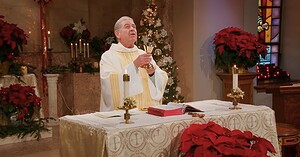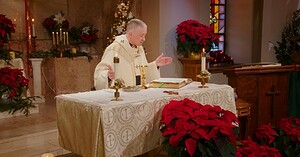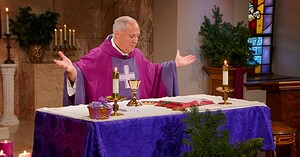The Most Holy Body and Blood of Christ
Homily Video
The Most Holy Body and Blood of Christ Homily Transcript
So again today we celebrate the Feast of Corpus Christi, the Body and Blood of Our Lord. Here in our Mercy Home Chapel, there’s a beautiful Tabernacle. It’s kind of off screen right now, but maybe our directors can get a shot of it later on or something. You don’t want to see it right now because Father Scott is standing there on his head with cue cards for me. But anyways, the Tabernacle says “bread of life” in Latin. Bread of Life.
So, when we reach into the Tabernacle, when we receive from Our Lord here in the Eucharist, we really are receiving life. A couple elements, and there’s so much to talk here about the Eucharist and especially these very rich readings this morning.
We have Melchizedek in our first reading. Melchizedek is sort of a cryptic, mythological figure almost. He was the first king of Jerusalem and we don’t know his origins. It’s kind of, he has this sort of eternal quality about him—no beginning, no end. But he establishes a priesthood.
Now what’s interesting in ancient Israel is there was an order of priests that were of the tribe of Levi. They managed the temple in Jerusalem. So they were in charge of offering all the sacrifices—the animals, the incense, kind of making sure the building was kept up and so forth. But then there was another strain or another order of priests that had kind of been forgotten or they had gone underground. And this is the line or the order of Melchizedek.
Melchizedek was the first priest, and you could say Aaron, who was of the tribe of Levi, was the first priest of the Levitical priesthood. When Jesus comes along, Jesus basically is saying, “I’m not a Levite.” I’m not one of these guys that are just taking care of the temple, you know, offering animals and incense. I’m a guy in the line of Melchizedek.
And so what does Melchizedek do? Melchizedek takes bread and wine when Abraham has been victorious in a battle, and he offers it up to Abraham and to God. And then Abraham gives Melchizedek a tenth of everything. So Melchizedek has this aspect of worshiping God, of really offering oneself. And so this is what Jesus does on the cross. He’s offering Himself on the cross to the Father.
When we as priests celebrate the Mass, this is one element of the Mass—we’re worshiping God. So there’s kind of a vertical dimension, if you will, to the Eucharist—us connecting to God the Father in Jesus Christ. And then the Holy Spirit is flowing through us. By the way: Father, Son, Holy Spirit—why we’re following this up with the Holy Trinity.
So that’s one element—the vertical aspect of the Eucharist. But then there’s, of course, the horizontal aspect of the Eucharist, which is why we call it Communion as well. Communion, a sharing of minds and hearts. We come together as a body. And this is why we also have now this Gospel reading of Jesus feeding the multitude.
Notice what Jesus does. He’s very intentional about this. He gets the people out into a deserted place. He kind of wears them down all day with teaching, if you will—gets them tired. And then they’re in this dilemma, okay, what are they going to do? We can’t just send them away because they’re going to collapse on the way home, so He’s going to feed them. And obviously, they can’t get enough food from nearby villages, so He’s going to perform this miracle.
So He’s intentional about bringing them together, making them hunger, and then He’s going to provide for them. But you notice what He does. He says, first, “Get them in groups of 50s and 100s,” so they gather in cohorts, if you will. So it’s very orderly, kind of like the way we sit in a church, right? Structured pews. And then He says, have them sit down and recline.
There’s something about sitting down. When you’re sitting down, it’s actually, ironically, someone calls it taking a stance. When you sit down—not just like kind of laying down on the couch eating potato chips or whatever—but kind of in an upright posture, you’re there to receive, and you’re focused. But you’re also relaxed, different than standing.
So just like when you sit down to eat a meal versus the way I eat—just standing up eating cottage cheese over the sink or something, right?—when you sit down to eat, you’re focused, and you’re saying, “I’m giving this time for this meal and the people in front of me.” That’s what Jesus wants them to do—to be together, focused, and then sharing not just with Him, but with each other in the crowd. And then, you know, they’re all going to pass the baskets of fish and bread to one another.
So this is what the Eucharist does. It really unites us as a body, unites us as a community. And again, why it’s so important that we come to Mass. Yes, when we come to Mass, we are filled individually with love from God, but in a way that we can’t tell and we can’t feel always, we’re connected to each other.
So it’s very powerful for a family to come together to Mass, or say like they gather together for a funeral Mass. You know, a family might be grieving or a family might be experiencing division. The Eucharist can bond each other, bond all of us together.
And think about it—you know, you’re sitting in a church with people who might look differently from you. They’re of a different socioeconomic status. Might be different politically, theologically. You know, here we are as Americans and, you know, different nationalities even. But in the Eucharist, we all come together, and we’re united in love in the Trinity. And so we thank God for giving Himself to us in His Body and Blood. May we receive it. May we become like Him. And may the Kingdom of God come about. Amen.
Readings
Featured Text
Discover More
The Holy Family of Jesus, Mary and Joseph
December 28, 2025
The Nativity of the Lord
December 25, 2025
Fourth Sunday of Advent
December 21, 2025
Request Sunday Mass Guide
The Sunday Mass Guide sent to your home address
Spiritual nourishment and updates from the Sunday Mass community
Monthly reflections from Fr. Scott Donahue, our Principal Celebrant


